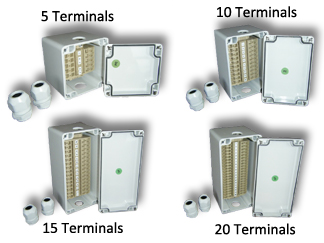Electrical Boxes
Local building codes and the National Electrical Code (NEC) require the use of specific types of electrical boxes in certain applications, while industry regulations may require businesses to use other variants for commercial applications too.

Image Source: digikey.com
Uses of Electrical Boxes
Electrical boxes can be mounted on wall surfaces, behind walls and in recesses, or even on ceilings. This flexibility of installation makes them incredibly useful for a number of different applications, like:
- Splicing or joining wires in electrical circuits and wiring.
- Housing connections for electrical appliances, lighting fixtures and the like, and mounting them on walls or ceilings for easy access.
- Electrical boxes that are appropriately rated, mounted and braced can be used to house and mounting ceiling fans and their connections.
- Electrical boxes are available in a variety of materials and sizes for different applications, which can protect wiring, circuitry and against electrocution.
- They provide easy access to the circuitry and components for repairs and maintenance.
- Live wires can also be grounded for added protection and to prevent short circuits.
- They are available in metal, plastic and synthetic bodies and can be wired using metallic wire and conduit, as well as non-metallic cables.
Types of Electrical Boxes
Electrical boxes come in a wide variety of different configurations, each with a specific range of intended use. These include:
Junction Box – Junction boxes are never used for housing switch, fixture or receptacle connections, only wires connected to each other. These electrical boxes allow you to safely split circuits and create branches in different directions.Handy Box – For applications where mounting electrical boxes behind walls or in recesses isn’t possible, handy boxes can be used to house receptacles and light switches. They can be directly mounted on a wall’s surface, without making any major modifications.
Outdoor Box – Outdoor boxes are available as non-metallic and metallic units, and are designed for most outdoor applications. These typically include features that protect wiring and circuitry from the elements, like sealed seams, gaskets and watertight covers.
Old-Work Box – Also called remodeling boxes, old-work boxes have clamps built into them, so they can hang on to existing drywall. These are ideal for installation after a drywall has already been hung.
New-Work Box – New-work boxes are installed by mounting them directly to joists or studs. These electrical boxes are designed to be installed during new construction and by using a bar hanger.
Metal Box – Metal boxes have some unique characteristics, which is why local building codes in many places require their use instead of PVC or plastic ones. They are usually a lot more durable and perform well for a much longer time.
PVC or Plastic Box – PVC or plastic boxes are an easy-to-install and inexpensive solution for placing electrical boxes behind drywall, in both old-work and new-work situations.
Square Box – Square boxes are composed of galvanized metal and can be used in new construction. They accept wiring from two devices.
Standard Rectangular Box – Standard rectangular boxes are the most common type of electrical boxes. They can only house a single outlet, receptacle or switch.
Round or Octagonal Box – These electrical boxes are designed to be mounted on ceilings and can only accommodate lightweight safety devices and fixtures like small light fixtures and CO2/smoke detectors.
Ceiling Box – Ceiling boxes are used for housing heavier devices and fixtures, like chandeliers or ceiling fans. Before installing one, you should ensure that it is designed to support at least the load it’ll need to bear.
Electrical Boxes Accessories
There is a wide range of accessories and fitting designed to be used along with electrical boxes. They can improve various capabilities like safety, flexibility and aesthetics:
Box Covers – After installing an electrical box and attaching the wiring from the devices, you need to use an appropriate cover. A box plate is basically a flat plate that can be mounted on the box with screws, and there are various options available:
- Indoor outlet boxes and light switches can be covered with plain or decorative covers.
- Outdoor boxes require watertight covers, or an in-use cover for receptacles. These allow access to the outlet while still keeping it covered completely.
- Plain box covers can be used for keeping the wiring safe from the elements and accidental contact, while still allowing access for repairs and maintenance.
Braces and Bar Hangars – Lights and other devices can be mounted between joists using braces and bar hangars, so they can be installed in different locations with relative ease.
Extension Rings – If an electrical box needs to accommodate multiple wires, an extension ring can be used to increase the total depth and provide more space for wiring.
Adjustable Depth Boxes-
These boxes can be adjusted to precisely install electrical boxes flush with a wall’s surface, regardless of the actual depth of the wall material.
